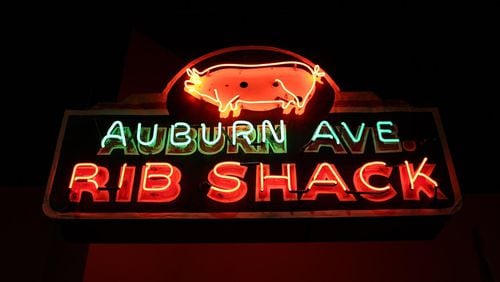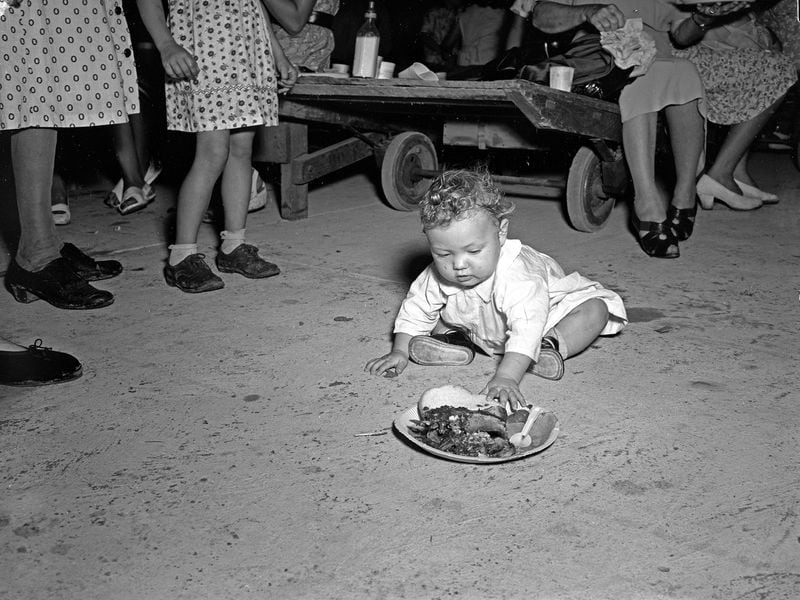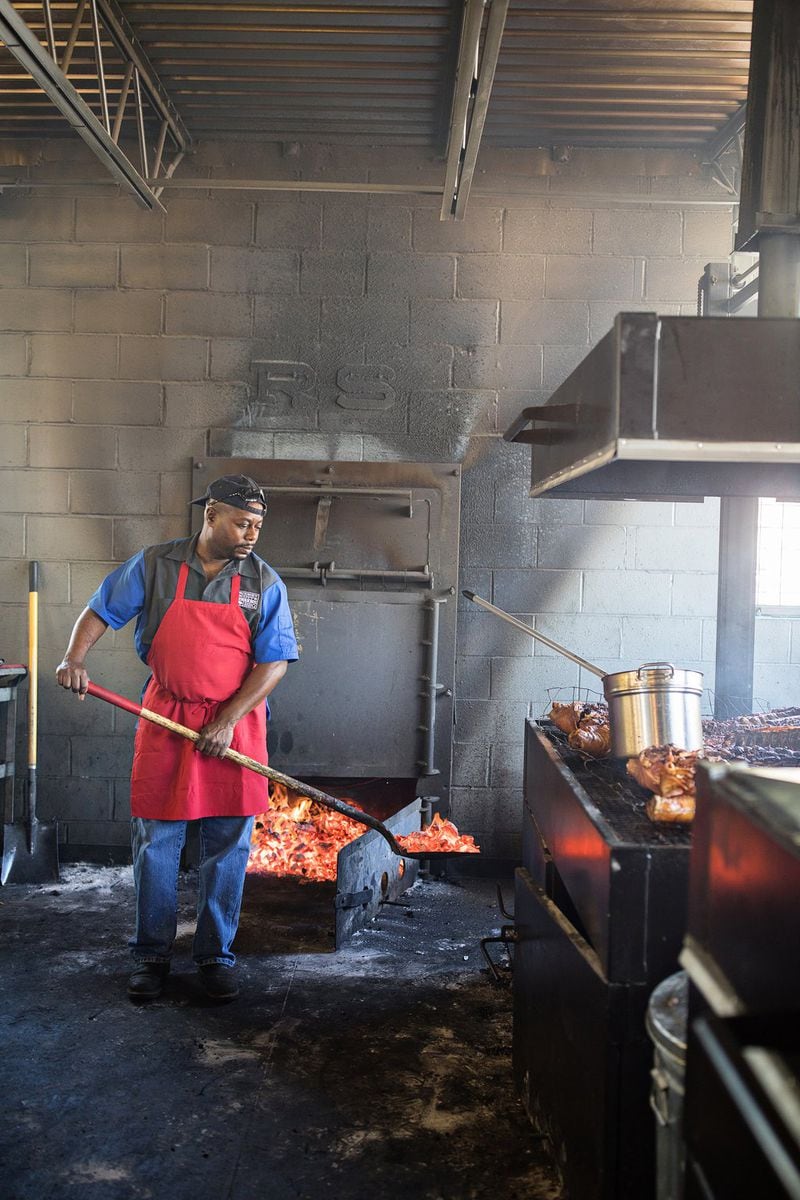In the fall of 1793, President George Washington crossed the Potomac River and headed toward a construction site. He was joined by a group of masons, a regiment of artillery, and a crowd of onlookers. There, in an elaborate ceremony, they laid the cornerstone for what would become the United States Capitol building. To celebrate, they ate 500 pounds of barbecue.
If there is a cornerstone to "Barbecue Nation," a new food-centric exhibition opening at the Atlanta History Center on May 5, it is the idea that barbecue is a truly American food. Meat cooked with smoke and fire is indigenous to North America and inextricable from the United States we know today. Across 3,300 feet of exhibition space, "Barbecue Nation" is a diverse celebration of that fact and how it came to be.
It is an effort some years in the making. In a recent conversation, author Jim Auchmutey recalled first being approached about the idea of a barbecue-centric exhibition at the History Center more than 10 years ago. He and former The Atlanta Journal-Constitution food editor Susan Puckett had published “The Ultimate Barbecue Sauce Cookbook” a few years earlier, a first-of-its-kind volume that approached the question of barbecue sauce with an almost encyclopedic zeal. Telling the story of barbecue in a museum exhibition, though, presented a different kind of problem.
As Auchmutey explained, “There’s not one narrative or one story to tell. There isn’t a Mr. Barbecue.” Or Ms. Barbecue, for that matter.
Efforts that try to explain American barbecue tend to hew closely to what might be called the four dominant traditions: Texas, Kansas City, Memphis and the Carolinas. They are the most popular, most imitated, and, perhaps, most loved styles of cooking meat with fire in this country. Yet, to divide his attention between only those stories, Auchmutey thought, would be a gross oversimplification. “Put simply, it misses the point,” he says.
To tell the story of barbecue, one would need to look at more regions and identities, across race and gender, through both industry and art. One would need a big tent and to invite everyone in it.
Auchmutey slowly assembled the materials for this ecumenical approach, bringing the stories of many small, localized traditions (Santa Maria barbecue in California, for example) into conversation with the long arcs of American history and culture. It wasn't the only thing on his desk. In the intervening years, Auchmutey retired from his long-held post as a writer and editor at the AJC and wrote "The Class of '65," a work of narrative nonfiction that grapples with the continued history of the civil rights movement. If it sounds like he might have assembled too much for a single museum exhibition, well, he did. Auchmutey's book-length, illustrated history of barbecue will be published by the University of Georgia Press next year.
After Auchmutey stepped aside from this research, Jonathan Scott, lead curator for “Barbecue Nation” at the Atlanta History Center, eventually took over and saw the exhibition to completion over the past six months.
The result is an exhibition organized around both thematic concerns and chronological arcs, rather than well-known barbecue traditions. It skips across the continent, looking at the way identity and history helped shape the myriad permutations of barbecue we know today. As Scott explained, “We made this as inclusive an exhibition as we could.”
To understand the intent and angle of their combined efforts, you might consider Allyn Cox’s 1955 mural, reproduced for the exhibition, depicting the story of the Capitol cornerstone being laid in 1793. It is a fine painting, if a little dry. It may seem to your eyes like an easy, simple story to celebrate, this early intersection of American history and barbecue.
Yet, the work here is in the details. As the accompanying label notes, “Even though the labor for both the Capitol construction and the barbecue was largely executed by enslaved people, only white men and women are depicted in this piece.” Even in this, one of the earliest stories of American barbecue, one version of the history has found a way to exclude the very people central to the art of it.
“Barbecue Nation” is a vivid correction to that. Instead of those exclusionary versions of history, the exhibition labors to invite everyone in. In the Atlanta History Center’s atrium, a smoker custom-made in Texas and shaped like a NASA space shuttle has been installed to pique curiosity. A glowing neon sign has been commissioned and installed at the front, like any good roadside joint welcoming a visit.
Inside, there are artifacts from across the country dating back as much as three centuries. There are excellent, short documentaries produced by the Southern Foodways Alliance as well as footage pulled from decades-old presidential archives. There are chopping blocks, butcher’s knives, cash boxes and nearly every other tool needed to run a barbecue joint. There are recordings of old barbecue stories piped in on speakers and a jukebox’s worth of barbecue-inspired songs. There’s a re-creation of a smokehouse complete with something called a “scent cannon,” which will pump in the scent of smoke.
What do all these collected things say? Well, along the way of walking through this exhibition, you begin to recognize the way that you're actually learning about the cultural history of this continent, that such a history is indivisible from the history of meat, fire and smoke. That point is made obvious through the stories of Native Americans, whose techniques of cooking with fire and coals became known as "barbacoa" to Spanish colonists. It is present in Pamela Alexander's oral history recorded by Auchmutey, where she recounts how the Rev. Martin Luther King Jr. and other civil rights leaders came to her barbecue restaurant in downtown Atlanta, Aleck's Barbecue Heaven, to strategize. One can hear it in the songs of Outkast and Kenny Chesney.
You might even be able to glimpse it in the rust of pitmaster Rodney Scott’s burn barrel, a towering tool of barbecue presented here with the deserved gravitas of a Richard Serra sculpture. It is an old, welded thing pieced together from oil drums and scrap metal, and if you look closely enough, you can see how the long arc of history and the sweat of life’s work sometimes come together just to make a delicious sandwich.
By moving the focus beyond those familiar four dominant barbecue traditions and the typical arguments about authenticity that accompany them, the curators here have latched upon a nugget of truth, that what we eat is always part and parcel of who we are.
EXHIBIT PREVIEW
“Barbecue Nation”
May 5, 2018-Sept. 29, 2019. Opening day highlights on May 5 begin with a keynote talk at 11 a.m. by pitmaster Chris Lilly of Big Bob Gibson Bar-B-Q in Decatur, Ala., as well as Erika Council of the Southern Soufflé blog preparing desserts and sides in the Smith Family Farm kitchen starting at noon. Demonstrations of meat preservation techniques, live music by Bluegrass Flashmob, make your own spice rub and other hands-on activities, food-related scavenger hunts and more. $21.50; seniors and students 13 and older, $18; children ages 4-12, $9; free for children under 4. Opening day activities are free with paid general admission. Atlanta History Center, 130 W. Paces Ferry Road, Atlanta. 404-814-4000, atlantahistorycenter.com.








